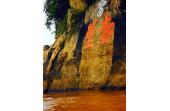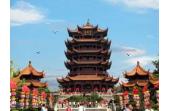Wuhan
- Things to do
-
- Photo(53)
- Tips&article(236)
- Make it Happen
- Map
-
loading...
Top 5 Lists
Wuhan(武汉; Wǔhn) is an interesting large city in the inland central area of China that somehow feels less modernized than China’s coastal cities or Beijing, but it is one of China’s main high-tech, education and financial centers. It is China’s 10th largest city. It is interesting for tourists because there are scenic areas and the big Yangtze River. The people are unusually cordial to foreigners. Because it is right in the middle of the navigable part of the Yangtze River between Shanghai on the coast and Sichuan and Chongqing far to the west, it has long been a transportation hub. The old town of Hankou that is now a part of modern Wuhan was China’s second largest commercial center after Shanghai during the 1800s and early part of the 1900s. Prices for meals and transportation are low, transportation to the city is unusually convenient, and it is an interesting tourist destination and a good place to start a tour of the Yangtze River basin.
Wuhan is now the capital of Hubei Province that is an inland province. It has a population of about 10 million people in its administrative area, with about 6,000,000 people in the main urban area and about 4,000,000 people in surrounding suburbs and towns. It is divided into three parts by the Yangtze River and Han River. The Wuchang district is the education center with many universities and research centers, the Hankou area is the financial and business district, and the Hanyang district is the industrial center.
This city has a certain charm about it. The people are unusual friendly compared to those in other cities. And if you have the time for a cruise, you might really enjoy going up the Yangtze on a cruise liner.
History
The city was originally three different towns around the place where the Han River merged with the Yangtze River (Changjiang, 长江, “long river”). The Yangtze River generally flows west to east across central China, and in the area of Wuhan, it flows from the southwest to the northeast. The much smaller Han River enters from the west.
The town on the southern bank of the Yangtze was called Wuchang. It was long known as an education center for Confucian scholars and literati, and for its arts, and it was a provincial capital during the Yuan (Mongolian) Dynasty. The town on the north bank of the Han River and the Yantze was called Hankou.
It was a financial and merchants center, and when the British controlled it during the 1800s, it became the second biggest financial and merchant center in China after Shanghai. The town on the south bank of the Han River between the Han and the Yangtze was called Hanyang. Now, it is the industrial area of the city with car factories, heavy industries, and advanced industries.
The British invaded the area during the middle of the 1800s, and used Hankou as a trading port. Goods from all over the British Empire, 1/7 of the world’s land area, came in on ships and were traded for goods from all over China, the most populous country in the world. The British had a small enclave along the river in Hankou of about 30 kilometers in area, and they built some buildings that still stand.
There is a large beautiful customs building that is still standing. It must have seemed very imposing then, since the architectural methods were advanced. Railroads were built that connected the British port with northern China, so it became one of the busiest ports in China. The Yangtze River allowed steamboats to carry merchandise more than 1,000 kilometers inland from the coast.
Modern History
In the last century, the area that is now called Wuhan was the scene of some important political events. First, starting about 1906, the Qing Dynasty governor of the area promoted the development of modern industry and education by founding important industries and opening modern schools and universities. Most of these universities were built in Wuchang. He wanted to modernize the area under his jurisdiction, so Wuhan became a leading city in China for industry, education and culture.
In 1911, there was a revolt against the Qing Dynasty government in the city promoted by Sun Yat-Sen, and then there was conflict all over China. In 1927, the Chinese KMT Nationalist government organized the old towns of Hankou, Hanyang and Wuchang into a city that was the capital city of China. The national government met in the Hankou District for a short time. In 1939, Wuhan became a Japanese military headquarters, and the city was destroyed by the US Air Force in 1944.
Tips & articles
|
|
|
forum discussion
|
|
|











